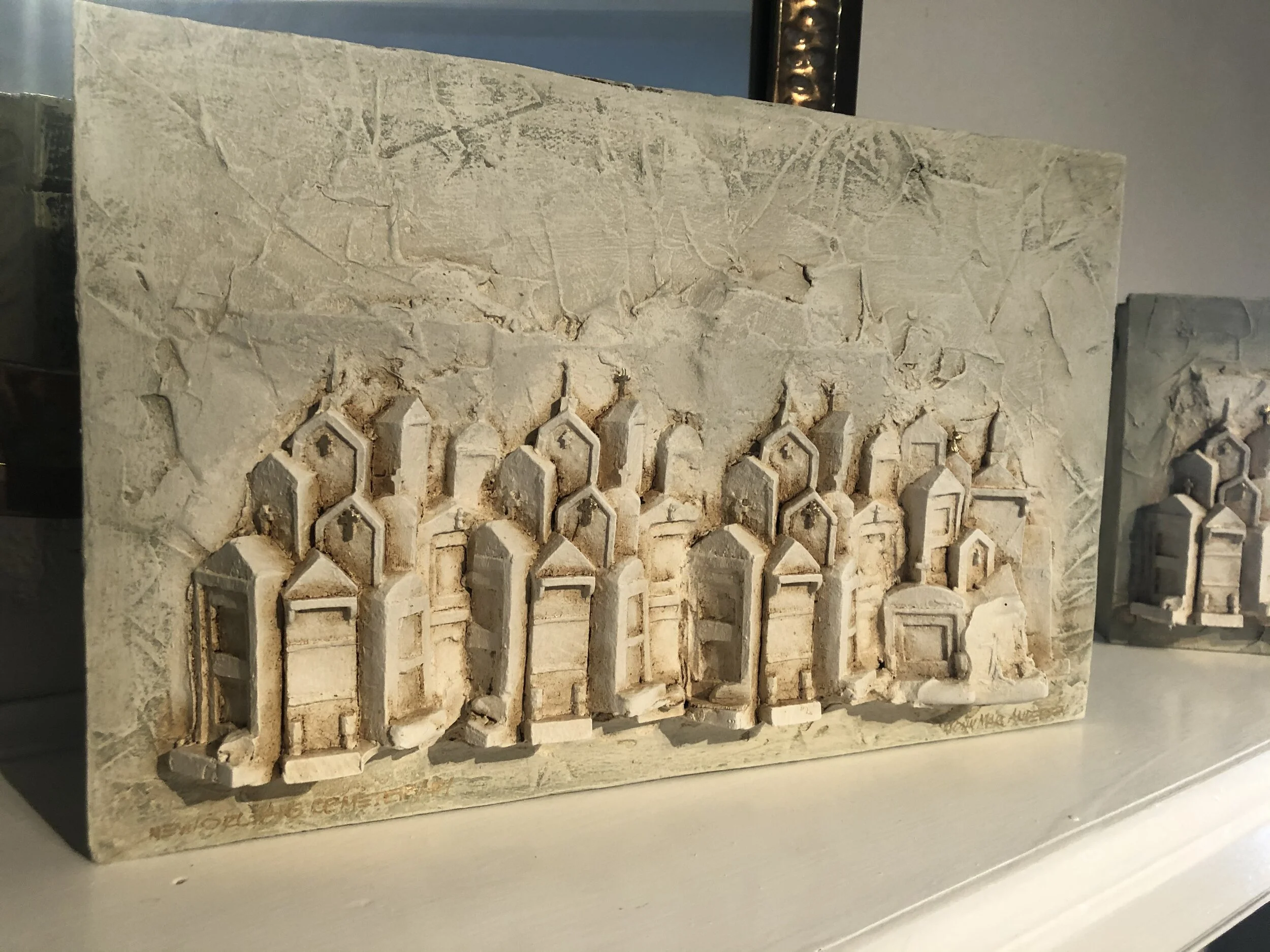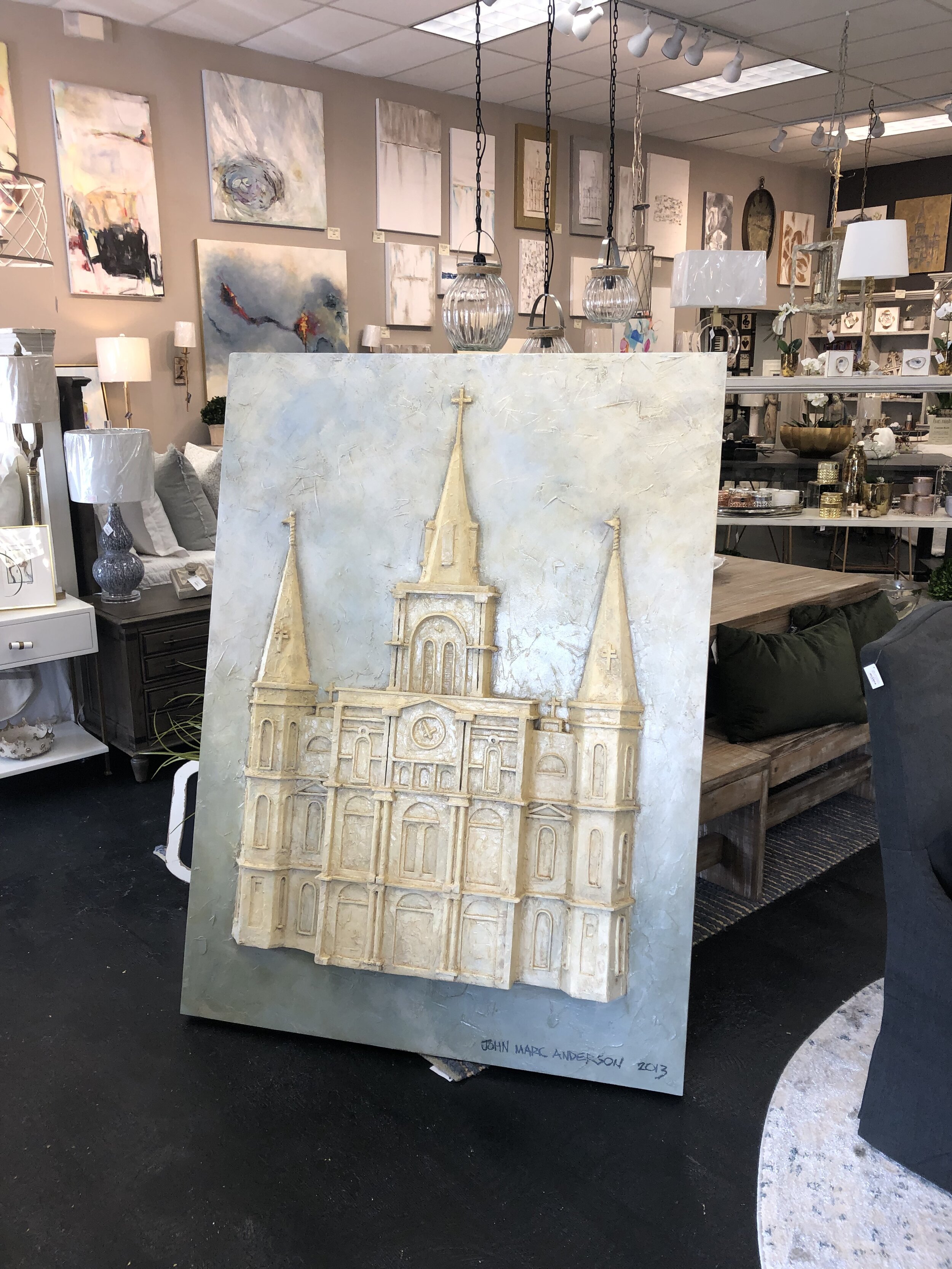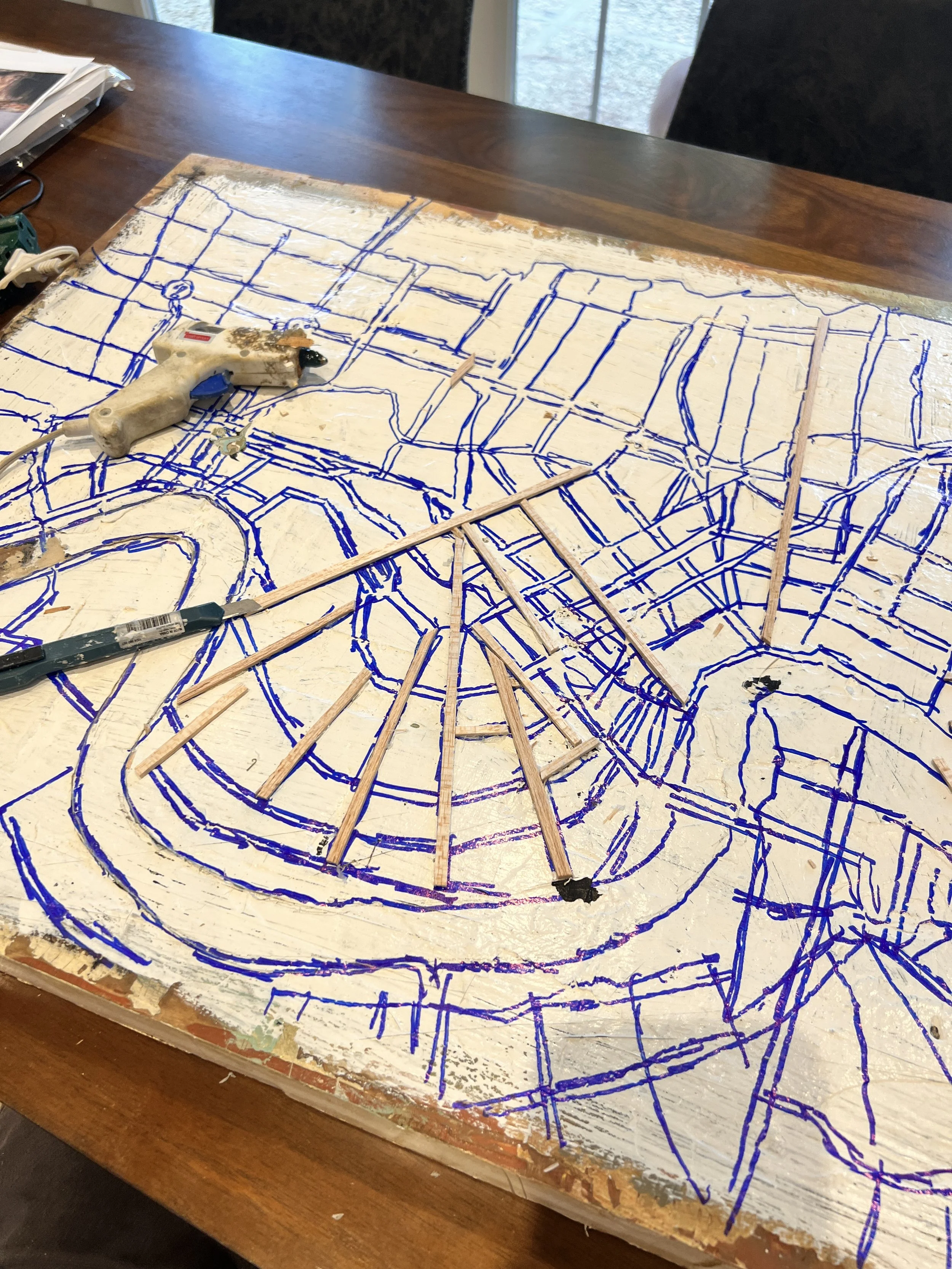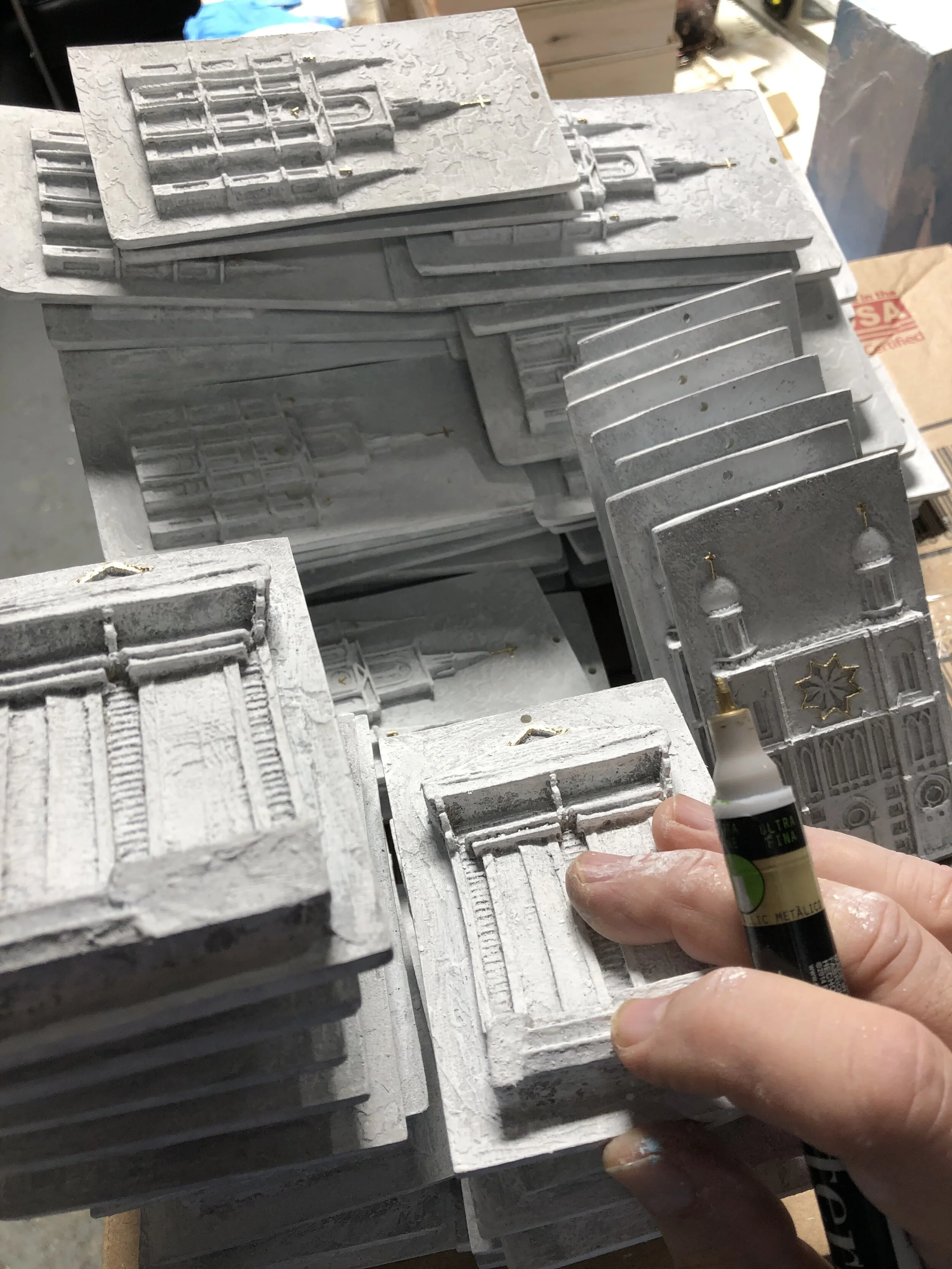ABOUT JOHN MARC ANDERSON
John Marc Anderson specializes in bas relief, a sculpting technique where figures or designs are slightly raised from a flat background, creating a sense of depth while maintaining a relatively low profile.
John Marc Anderson is a bas relief artist, designer, and draftsman. Growing up all over the world in a military family, he settled in the Washington, DC area and is a graduate of The University of Maryland at College Park.
His process starts with original relief works carved in dense polystyrene foam, and incorporates laser scanning, 3-D printing technology, mold making, casting, and the use of unique materials to create miniaturized reproductions of his subjects. Often, salvaged or repurposed materials are used in creating his work.
Based in New Orleans, Louisiana, Marc’s familiar interpretations of iconic landmarks such as The St. Louis Cathedral, The Jesuit Church (Church of the Immaculate Conception) and the city’s world famous cemeteries are familiar to locals and international visitors alike.
Marc’s studio designs and creates unique artwork for institutional advancement programs, weddings, memorials, and special projects.
He spent 30 years as a CEO and entrepreneur in the specialty bedding industry and helped pioneer the “bed in a box” mattress industry as a designer, manufacturer, and inventor.
Typically working in bas relief (low relief), Marc’s subject matter captures iconic Louisiana architectural or cultural landmarks, most notably of which are his soaring depictions of The St. Louis Cathedral.
New Orlean’s incredible cemeteries are among the most hauntingly beautiful sites to visit, anywhere in the world. Marc’s interpretations of our Cities Of the Dead are hugely popular, and various pieces in many sizes can be found at select retailers in the New Orleans area. Visit Marc’s where to buy section fo find a retailer near you.
An example of a custom made piece featuring a rendering of the St. Louis Cathedral. This piece was created for a private residence and is 65” tall x 50” wide. Custom pieces of residences, churches, or other prominent New Orleans architectural icons can be created for you. Contact the studio directly at 985 966 7000 for further information.
Laying the original design and intricate inlaid features of Marc’s three dimensional New Orleans City Map used 8 different reference maps and cartographical surveys to complete.
After creating his original works and having them meticulously laser scanned and preserved, Marc uses high definition 3D printers in his studio to create reproductions which can then be cast and reduced in size to create stunning high definition artworks, all of which are hand finished and signed by Marc personally.
Marc’s selection of New Orlean’s themed seasonal ornaments are among his most popular works. Each is hand finished and stained, and signed with his signature gold leaf ink. Collected by locals and visitors from all over the world, nothing says “Nawlins” like Marc’s incredible three dimensional art.
Marc’s process begins with an original sculpture that is completely cut by hand. In this case, a portion of a stylized cello is being created. When finished, the work will be laser scanned, and an original 3D prototype will be printed to enable multiple castings of certain works.
After laser scanning, reduction, and 3D printing of Marc’s original works, reproductions can be made using unique metal finishes, stains, and paints, many of which are salvaged. The studio creates all of the solid wood back panels which are a signature elements of Marc’s works.
“Louisiana Girl”, a relief study of the paddle wheeler “Creole Queen”.
A UNIQUE AND ORIGINAL PROCESS
Most collectors of Marc’s work are familiar with his unusual process. Beginning with a rigid foam sculpture that typically measures up to 60” wide by up to 72” tall, he carefully hand carves each original from memory, using no frame of reference other than his own quick sketches and renderings.
Larger pieces, including his iconic interpretations of The St. Louis Cathedral, can be found above many fireplace mantels, in corporate offices, businesses, restaurants, but mostly, on Christmas Trees. His Christmas Ornaments are hugely popular with natives and visitors alike. Visit Marc’s page to find a local dealer near you, and keep watch of his Events section, too. Marc typically does 2-4 street shows and events a year.
restoring the iconic treasures of new orleans
The St. Louis Cathedral was originally constructed in 1727 and remains an active church to this day, having survived fires, flooding, and hurricanes.
For more than 10 years, the St. Louis Cathedral has been Marc’s most frequently interpreted subject. The building itself is strikingly simple in design, with a majestic facade, and steeples that pierce the sky”, he says of the cultural icon. “It is the centerpiece of New Orleans, and it needs to be preserved for future generations”.
In fact, the building itself is in great distress, with decaying plaster, termite infestation, and a settling foundation, and is undergoing a massive restoration that hasn’t gained a lot of grassroots steam, even though a tremendous amount of private funds have been injected into the project.
preserving the st. louis cathedral for future generations
While private donors and local funds provide a substantial part of the cost for the current restoration project, it is estimated that a complete restoration, particularly that of the foundation along with the structure, might exceed $45,000,000, according to Our City Our Cathedral, a campaign undertaken by The Catholic Community Foundation.
John Marc Anderson Art will soon incorporate a limited series of works that include relics from the Cathedral incorporated into the art. Portions of the proceeds from the sale of these works will be donated to the restoration project.
A major contributor to the campaign is Gayle Benson, an American businesswoman who is the owner of the New Orleans Saints of the National Football League and the New Orleans Pelicans of the National Basketball Association.
Despite private sponsors best efforts, however, a grassroots campaign is necessary to encourage small donors to contribute to the restoration. You can read a detailed outline of the costs required to restore and maintain the Cathedral, here.
Restoring and preserving the St. Louis Cathedral is important for a variety of reasons, all of which greatly affect the welfare of the city of New Orleans.
Without this magnificent centerpiece which has graced the Mississippi riverfront for two hundred years, a strong sense of branding and cultural identity could be lost.
Why It Is Critical To Save And Preserve The St. Louis Cathedral
Historical and Cultural Significance: The St. Louis Cathedral is not just a religious landmark; it's also a symbol of New Orleans' rich history and cultural heritage. As the oldest continuously active cathedral in the United States, it holds immense historical significance. Preserving its architectural integrity ensures that future generations can appreciate and learn from this important piece of American history.
Architectural Heritage: The cathedral's stunning Spanish colonial architecture is a testament to the craftsmanship of the past. Its intricate details and elegant design are a source of pride for the city and serve as a reminder of the architectural styles that have shaped New Orleans' built environment over the centuries. Restoring and repairing the cathedral helps maintain this architectural heritage for future enjoyment and study.
Religious Importance: The St. Louis Cathedral is a place of worship and spiritual significance for the Catholic community in New Orleans. It serves as a gathering place for religious ceremonies, celebrations, and quiet contemplation. Ensuring that the cathedral is structurally sound and well-maintained allows for the continuation of these important religious practices and rituals.
Tourism and Economy: The St. Louis Cathedral is a major tourist attraction, drawing visitors from around the world to marvel at its beauty and learn about its history. The cathedral, along with other historic landmarks in the French Quarter, contributes to the city's tourism industry and economy. A well-maintained cathedral enhances the overall visitor experience and supports the local economy by attracting tourists to the area.
Community Pride: The St. Louis Cathedral holds a special place in the hearts of New Orleanians, serving as a symbol of community pride and resilience. It has weathered hurricanes, fires, and other challenges throughout its long history, emerging each time as a symbol of hope and perseverance. Restoring and repairing the cathedral reaffirms the city's commitment to preserving its cultural heritage and ensures that it remains a source of pride for generations to come.
NEW ORLEANS CEMETERIES: PRESERVATION AND RESTORATION
New Orleans Cemeteries are important architectural, cultural, and artistic treasures that need to be restored and preserved for the future.
Marc’s subject matter includes architecturally significant churches, iconic cultural artifacts, and New Orleans cemeteries. After Hurricane Katrina, because of the significant damage to many of the historically important cemeteries, there was a strong interest in preserving these fragile landmarks.
High water tables in the city require that entombments are built above ground, and architects and designers who created these vaults and graves were provided a unique way to showcase their skills and their art.
Thus, New Orleans cemeteries are treasure troves of ornamental metalwork, stone and masonry work, carved sculptures and tile work, antebellum mortuary art, and more.
Each cemetery has its own design sensibility, style, and vibe. More like outdoor museums than a conventional below ground cemetery, walking between the rows and walled and stacked tombs feels much like wandering through a city or village.
Marc’s cemetery artworks generally incorporate a blended style that reflects all of the architectural elements you can find, from Old Cemetery #1, Metairie Cemetery, St. Roch’s, to Lafayette Cemetery.
New Orleans is known for its unique and historically significant cemeteries, often referred to as "Cities of the Dead" due to their elaborate above-ground tombs.
There is an increasing sense of awareness about the fragile nature of these cemeteries due to many factors, including the frequency of flood waters created by hurricanes, damage caused by high moisture to structural and decorative elements, and lack of restoration and preservation awareness.
Surprisingly, cemetery art has become increasingly popular among locals as well as tourists. Marc has devoted more time over the last few years to create relief works that capture the quiet grandeur of these historically significant sites.
Descriptions of the most significant cemeteries in New Orleans:
Saint Louis Cemetery No. 1: This is the oldest cemetery in New Orleans and is famous for being the burial site of Voodoo priestess Marie Laveau. It also contains the tombs of prominent figures from New Orleans' history.
Lafayette Cemetery No. 1: Located in the Garden District, this cemetery is known for its picturesque above-ground tombs and its appearance in numerous films and TV shows.
Metairie Cemetery: One of the largest and most prestigious cemeteries in New Orleans, Metairie Cemetery contains the graves of many notable individuals, including politicians, military leaders, and celebrities.
Garden District Cemeteries: Besides Lafayette Cemetery No. 1, there are several other smaller cemeteries in the Garden District that are notable for their historical and architectural significance.
St. Roch’s Cemetery: St. Roch's Cemetery is dedicated to St. Roch, the patron saint of miraculous healing. The cemetery is part of the complex that includes the St. Roch Chapel, built in the late 19th century as a place of worship and healing for those afflicted by epidemics, particularly yellow fever. Devotees of St. Roch visit the cemetery and chapel to pray for healing and protection, making it a site of religious pilgrimage and devotion.
Preserving these cemeteries is important for several reasons:
Historical Significance: New Orleans cemeteries are repositories of the city's rich history. They contain the remains of individuals who played significant roles in shaping the city's culture, politics, and society. Preserving these cemeteries helps to maintain a tangible link to the past.
Cultural Heritage: The above-ground tombs found in New Orleans cemeteries are iconic symbols of the city's unique cultural heritage. They reflect a blending of different cultural influences, including French, Spanish, African, and Caribbean traditions. Preserving these tombs helps to safeguard this cultural heritage for future generations.
Architectural Value: Many of the tombs and monuments in New Orleans cemeteries are architecturally significant, showcasing a variety of styles and designs. They are often adorned with intricate carvings, sculptures, and other decorative elements. Preserving these architectural treasures is essential for maintaining the city's aesthetic character.
Tourism and Education: New Orleans cemeteries are popular tourist attractions, drawing visitors from around the world who are interested in exploring the city's history and culture. Preserving these cemeteries ensures that future generations will be able to experience and learn from them.
Environmental Considerations: New Orleans' low-lying geography makes it vulnerable to flooding and other environmental hazards. Preserving cemeteries can also have environmental benefits, as they often serve as green spaces within the urban landscape, providing habitat for wildlife and helping to mitigate flooding and erosion.
Overall, the preservation of New Orleans cemeteries is essential for maintaining the city's cultural heritage, historical identity, and architectural legacy.
Interested in becoming a partner? If you are a retail store, gallery owner, or private collector, write me at johnmarc56@gmail.com.









